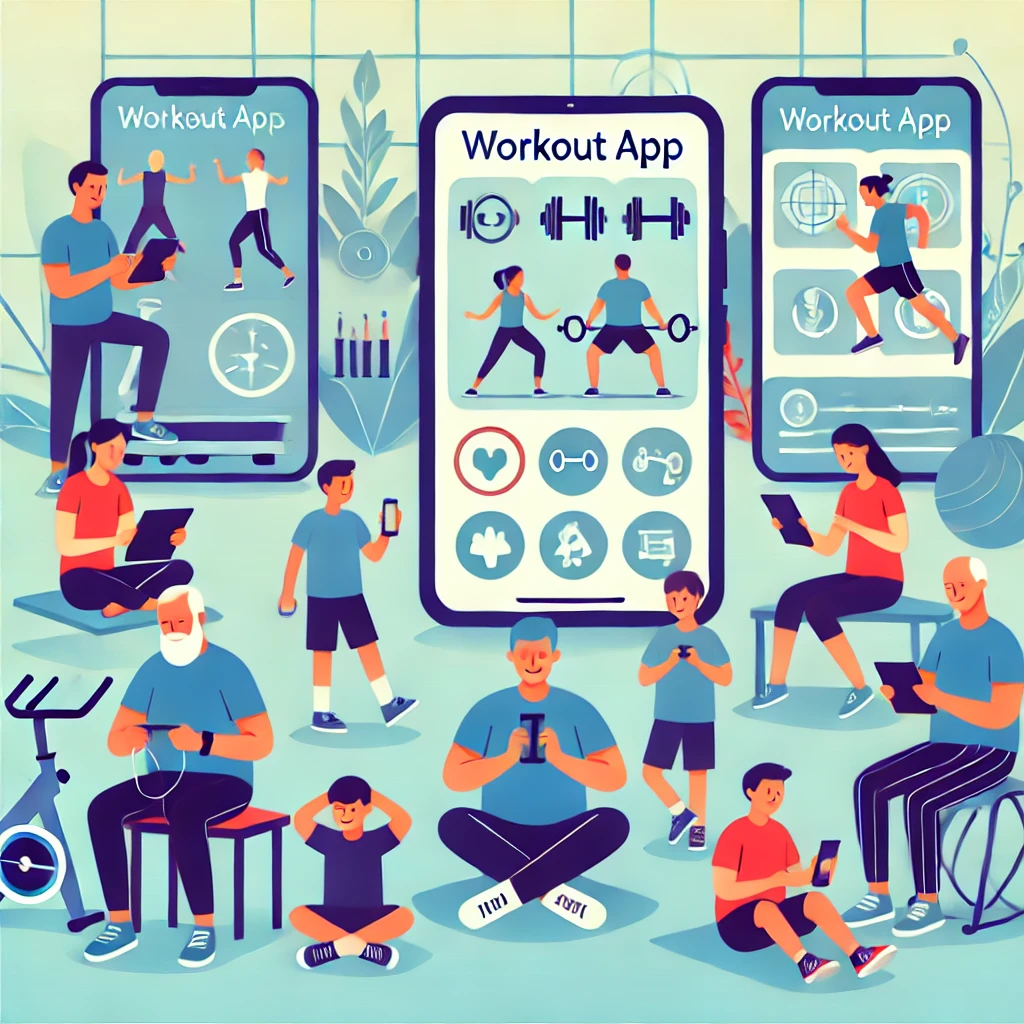As the global population ages, the demand for health and wellness solutions tailored to seniors is on the rise. Fitness apps designed specifically for older adults have the potential to improve their quality of life, promote independence, and address age-related health challenges. However, developing fitness apps for seniors requires careful consideration of accessibility and usability to ensure that older users can easily navigate the app and engage with its features.
In this article, we’ll explore the key elements involved in developing fitness apps for seniors, the importance of accessibility and usability, and how partnering with a fitness app development company can help create user-friendly solutions for this demographic. We’ll also discuss how emerging tech development can enhance the experience for older adults by integrating features that address their unique fitness needs.
The Growing Demand for Senior-Friendly Fitness Apps
The number of seniors using smartphones and mobile devices is steadily increasing, making fitness apps a valuable tool for helping older adults stay active and healthy. Regular physical activity is critical for seniors, as it helps improve mobility, balance, and cardiovascular health while reducing the risk of chronic conditions like arthritis, diabetes, and heart disease. Fitness apps can provide structured workout routines, track progress, and offer motivational support, making it easier for seniors to incorporate exercise into their daily lives.
However, for seniors to truly benefit from fitness apps, these apps must be designed with accessibility and usability in mind. Older adults often face challenges such as reduced vision, hearing, dexterity, and technological familiarity, which means that traditional app designs may not be suitable for this demographic. Ensuring that fitness apps are easy to navigate and use is essential for helping seniors achieve their fitness goals.
Key Considerations for Accessibility and Usability in Senior Fitness Apps
When developing fitness apps for seniors, it’s essential to prioritize accessibility and usability. Here are the key features and design considerations that make fitness apps more accessible to older adults:
1. Simple and Intuitive User Interface (UI)
A user-friendly interface is critical for ensuring that seniors can easily navigate the app without frustration. Complex layouts, small buttons, or confusing menus can make it difficult for older adults to interact with the app.
Designing a Senior-Friendly UI:
- Use larger buttons and icons that are easy to tap, reducing the likelihood of misclicks.
- Avoid cluttered screens by presenting only essential information, with clear labels and simple instructions.
- Create a logical flow for the user journey, minimizing the number of steps needed to access key features like workouts or health tracking.
- Consider using high-contrast colors and large, legible fonts to accommodate users with vision impairments.
By simplifying the app’s design, developers can ensure that seniors feel confident and comfortable using the app, regardless of their technological expertise.
2. Voice Command Integration
Many seniors may have limited dexterity or difficulty using touchscreens. Integrating voice command features allows them to control the app using simple voice prompts, making the app more accessible and easier to navigate.
Benefits of Voice Command for Seniors:
- Users can start, pause, or stop workouts using voice commands instead of tapping buttons.
- Seniors can ask the app for their progress updates or instructions on how to perform an exercise.
- Voice commands reduce the need for manual input, making the app easier to use for those with mobility challenges.
Voice command integration is particularly useful for seniors who may have arthritis or other conditions that make it difficult to use their hands.
3. Customizable Workouts
Fitness apps for seniors should offer customizable workout routines tailored to their fitness levels and health conditions. Older adults may need lower-intensity exercises that focus on mobility, balance, flexibility, and strength.
Customizable Workouts for Seniors:
- Offer pre-set workout plans for different fitness levels, with a focus on low-impact exercises like walking, stretching, or chair yoga.
- Allow users to customize the duration and intensity of their workouts based on their comfort level and medical advice.
- Include instructional videos with clear, step-by-step demonstrations to guide users through each exercise.
By providing personalized fitness routines, fitness apps can cater to the unique needs of seniors, helping them stay active in a safe and manageable way.
4. Progress Tracking and Health Monitoring
Tracking progress is a key motivator for users of all ages, including seniors. Fitness apps can provide progress tracking features that allow older adults to monitor their activity levels, steps taken, calories burned, and other health metrics. Integrating wearable devices like fitness trackers or smartwatches can enhance this experience by providing real-time health data.
Health Monitoring Features for Seniors:
- Track steps, heart rate, and calories burned during workouts, providing insights into overall activity levels.
- Include features that monitor vital signs such as blood pressure or blood oxygen levels, especially for users with underlying health conditions.
- Provide easy-to-read graphs and charts that show progress over time, helping seniors stay motivated by visualizing their achievements.
Progress tracking and health monitoring encourage seniors to stay consistent with their fitness routines and provide valuable information they can share with healthcare providers.
5. Motivational Reminders and Notifications
Consistency is key to maintaining an active lifestyle, especially for seniors. Fitness apps can include motivational reminders and notifications that encourage users to stay on track with their fitness goals.
How Motivational Features Can Help:
- Set reminders for daily exercise sessions, hydration, or medication to support overall wellness.
- Send gentle nudges or words of encouragement to motivate users to complete their workouts.
- Allow users to customize the frequency and timing of reminders based on their personal preferences and daily routines.
Motivational features keep seniors engaged with the app and help them form healthy habits.
6. Accessibility Features for Vision and Hearing Impairments
Many older adults experience age-related vision or hearing loss, so fitness apps should include accessibility features that accommodate these challenges.
Accessibility Options to Consider:
- Provide adjustable text sizes and high-contrast color schemes to improve readability for users with low vision.
- Include audio instructions and cues for visually impaired users, and offer captions or subtitles for users with hearing impairments.
- Ensure that videos or workout demonstrations are easy to follow with clear audio and visual instructions.
By offering these accessibility options, fitness apps can reach a broader audience of seniors, ensuring that all users can benefit from the app’s features.
How Fitness Apps Benefit Seniors
Fitness apps designed for seniors offer a range of benefits that improve their physical health, mental well-being, and overall quality of life:
1. Improved Mobility and Independence
Regular physical activity helps seniors maintain mobility, balance, and strength, reducing the risk of falls and promoting independence. Fitness apps provide easy-to-follow routines that seniors can do at home or outdoors, empowering them to take control of their health.
2. Mental Health and Cognitive Benefits
Exercise is known to boost mood, reduce stress, and improve cognitive function. Fitness apps that incorporate mental wellness features, such as mindfulness exercises or relaxation techniques, can further enhance the mental health benefits of physical activity for seniors.
3. Increased Engagement and Socialization
Many seniors may feel isolated or disconnected, especially if they live alone. Fitness apps with social features, such as group challenges or virtual communities, offer opportunities for social engagement, helping seniors stay connected with others who share similar fitness goals.
4. Health Monitoring and Early Detection
By tracking vital health metrics such as heart rate or blood pressure, fitness apps can help seniors and their healthcare providers identify potential health issues early. This proactive approach to health monitoring can prevent complications and improve overall well-being.
The Role of Emerging Technologies in Senior Fitness Apps
Emerging tech development services can enhance the functionality of fitness apps for seniors by integrating advanced technologies that improve accessibility and usability:
1. AI-Powered Personalization
AI algorithms can analyze user data and provide personalized workout recommendations based on the senior’s fitness level, preferences, and health conditions. AI can also offer real-time feedback and adjust workout intensity to ensure safety and effectiveness.
2. Wearable Device Integration
Wearable devices, such as smartwatches or fitness trackers, can be integrated with the app to provide real-time health monitoring, offering seniors additional support for managing their fitness and wellness.
3. Telehealth Integration
Fitness apps for seniors can include telehealth features that allow users to connect with healthcare professionals directly through the app, providing real-time guidance, consultations, and medical advice when needed.
How a Fitness App Development Company Can Help
A fitness app development company can design and build fitness apps that meet the specific needs of seniors, prioritizing accessibility, usability, and safety. Developers can create user-friendly interfaces, integrate voice commands, and offer personalized workout plans that cater to older adults’ fitness goals. By focusing on senior accessibility, app developers can ensure that the app is easy to navigate and effective for users of all skill levels.
Conclusion
Developing fitness apps for seniors requires a thoughtful approach to accessibility and usability. By offering simplified user interfaces, voice commands. Customizable workouts, and health tracking, fitness apps can empower seniors to stay active, maintain their independence, and improve their overall well-being.For businesses looking to create fitness apps tailored to seniors, partnering with a fitness app development company and leveraging emerging tech development services will ensure the app is designed with accessibility in mind, providing seniors with the tools they need to live healthier, more active lives.






More Stories
Why Business Needs Mobile App Development Services in USA?
Remote Full Stack Developers in Dublin
How Azure Cloud is the Future of AI & ML